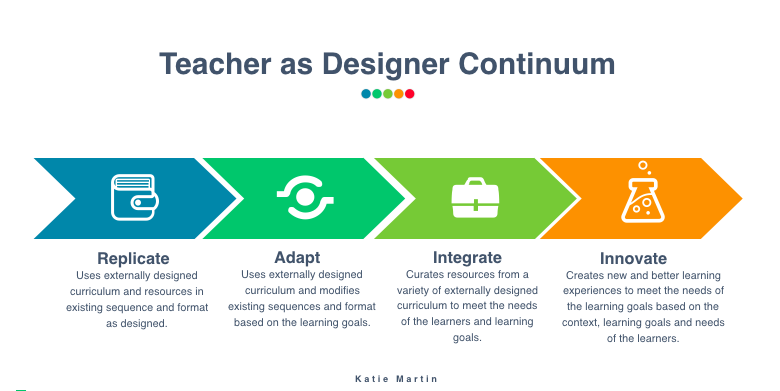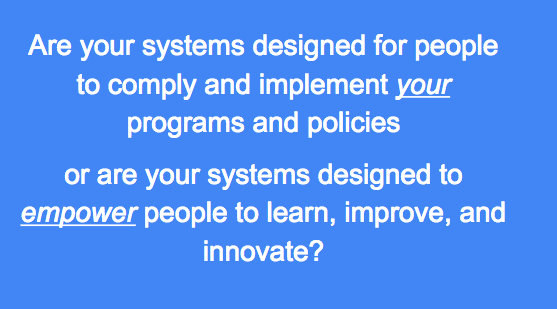What does your ideal classroom look like?
I asked a district leader a while back what his ideal classroom looked like and he responded, “It’s hard to put my finger on it but I know it when I see it.”
This response is more common than not.
Think about that for a minute. If you are a teacher in the school and your administrator can’t articulate what the desired teaching and learning looks like, how are you supposed to meet those expectations? At the same time if a teacher knows a better way to meet the needs of learners in their classrooms and doesn’t share their ideas or try something new because they assume they aren’t allowed, there may be great learning opportunities missed.
As I continue to talk to district and school leaders, there is a common refrain that we are “transforming teaching learning” yet when I talk to teachers there is rarely a clear understanding of what that means or what their role in that change is. In order to realize the type of learning and teaching that we believe is necessary in our classrooms today, we need to have more conversations about the what we want learners to know and do but we also need to admit that we may not have all the answers. We need to be willing to have conversations, seek out research and explore approaches together without punishment or fear, but in service of learners in each of our classrooms and each of our schools.
In this article,“How Does Professional Development Improve Teaching?” Mary Kennedy describes the conflicting messages that many teachers get about what they are expected to do in their classrooms. “[A]s a society we expect teachers to treat all children equally, yet respond to each child’s unique needs; to be strict yet forgiving; and to be intellectually demanding yet leave no child behind.” District leaders, principals, and teachers have different experiences and beliefs about what this means in each classroom and what policies and procedures need to be in place to get to our desired goals. The problem is that there is often a lack of common understanding about what this actually looks like in diverse classrooms.
Here are 3 strategies to define desired learning and teaching:
1. Talk about desired learning and teaching
This might sound like a no-brainer but I don’t think it happens nearly enough. What I have seen to be more powerful prior to (or instead of ) defining a certain model is to understand what we want our students to be able to know and do and how we can best design learning experiences and contexts to develop the type of learners we value.
One of my favorite strategies to do this is to have people reflect on their own learning experiences and share commonalities. No matter how often we do this activity, or how diverse the crowd, the themes of both the conditions and the context remain pretty consistent and similar to this graphic from Will Richardson.

2. Create a common understanding of desired teaching and learning
So what does good teaching and learning look like? Can you define this without any buzzwords? I often hear that districts or schools are “doing” personalized learning, blended or inquiry or project-based learning but there is still a great deal of variation in what people perceive this to be or what this actually looks like in classrooms.
When educators have opportunities to talk how we learn best and what that looks like in the classrooms, rather than what curriculum or program we are using, it can help create a shared understanding of the desired experiences that we are striving for in schools. Too often we make decisions based on assumptions, as well as our own beliefs and perspectives, rather that what is currently happening in classrooms. A great strategy is to visit classrooms (or look at case studies) and discuss what you notice. I wrote more about it here.
George Couros’ image of 8 things to look for in today’s classroom is a great example. What if you spent time with your staff talking about these look fors, adding your own, or creating your own list and examples that resonate in your context?

3. Define Expectations of Desired Teaching and Learning
In Scaling up Excellence, Bob Sutton & Huggy Rao describe the Catholic to Buddhist continuum that plays critical role on scaling efforts in diverse organizations. On one end leaders create expectations that allow for local, customized decisions (Buddhism) while the other end, they lean toward increased standardization and replication (Catholicism). They describe the role of leaders in “managing the tension between replicating tried-and-true practices and modifying them (or inventing new ones) to fit local conditions weighs on decision makers, shapes key events, and leads to success or failure.”
This continuum is relevant to schools and how we define the role of the teachers and curriculum. There are definitely foundational skills that students need to have to be successful in school and life but there also needs to be room for flexibility to meet needs of unique individuals. Many systems struggle with this balance.
An example of this Catholic/Buddhist continuum in schools might be:
Catholicism- A reading program where each student moves through the textbook/curriculum at the same page at the same time to ensure all learners have access to the the same content.
Buddhism- A reading program that outlines the skills and strategies students need to learn and allows for teachers to use resources based on the learners in their classrooms.
This graphic could be powerful to discuss as a staff or a district to define what you value and strive to do in your school to scale up best practices or create new ones.

Build the foundation, not the ceiling
The best teachers do not use just one approach, or follow one curriculum, they create the context and experiences for diverse learners to learn and grow. We can get fixated on blended learning or flipped learning or project-based or challenge face or inquiry (or whatever you want to call it) but the reality is to meet the needs of the kids in our classroom we need to utilize all approaches in a variety of ways depending on the learners and the learning objectives.
To do this well, we need to have more deliberate conversations about the type of learning and teaching we want to see in our classrooms, the best resources to make it happen, and how to support teachers to continually learn and create the most significant learning experiences for diverse learners in their classrooms.

3 Learner-Centered Movements I am Excited to See Grow in 2024
Almost a quarter of a century into the 21st century, I am excited to see the awareness and,...


“To create the most significant learning experiences for diverse learners in our classrooms. ”
Yes Katie, when everything else is said and done, this is the biggest challenge for teachers – to ‘cater for individual student’s learning needs’ – a phrase that has been repeated in the teaching world since the beginning of time….and yet is the most challenging to make happen. To just cover and implement the set curriculum is not hard – it’s only 50% of our job. It’s about how the teacher makes each student feel. Real learning can only happen when each student feels safe, happy and comfortable in their learning environment. No matter how awesome the learning experiences are, we need to begin with knowing our students. If we learn to understand who each student is and how they learn best, we can then attempt to mould our teaching and learning to suit their needs.
So many connections to this post and to the work we are doing! Leaders have to lead a “learner-centered” process of defining what powerful learning looks like. It’s amazing how many educators cannot articulate a vision for learning. It is what it is, and we have to start somewhere. These conversations TAKE TIME. It’s so much more than memorizing an academic definition or watching a video. Educators are LEARNERS in this process. There will be iterations, misconceptions, reflection, messiness and growth OVER TIME. We need to expect and value that in everyone working through these changes. Making connections to our own most powerful learning experiences IS the most effective way to get the ball rolling and make a personal connection to the change we’re working toward. The PROCESS leaders lead must mirror the learning we wish to see in our classrooms. And when it “clicks” for each INDIVIDUAL, it’s a beautiful thing. Bravo! Loved this post!
Hi Katie,
Is it o.k. for me to use your infographic in a presentation to teachers?
Of course! I’d love to hear how it goes.
Best,
Katie
Thanks Katie. Will let you know.